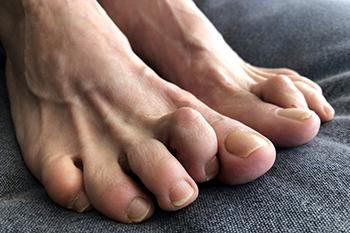
People who have the foot condition that is known as hammertoe will notice their toes are rigid. Hammertoe can happen from genetic reasons or from wearing shoes that do not have ample room in the toe area. This can cause the toes to shift together, and the pressure can make the second and third toes bend downward at the middle joint. It is sometimes painful while wearing shoes, and corns and calluses may form on the bent joint as it touches the top of the shoe. Stretches can be performed which may help to increase the toe's flexibility. A toe crunch is done while sitting in a chair, and placing a towel under your feet. The toes can be stretched by gripping the towel continually as you make your way to the end of it. An effective stretch can be done with a towel, as it is wrapped around the toes and pulled gently toward you. After holding for several seconds, this can be repeated. If you have developed hammertoe, it is suggested that you consult with a podiatrist who can help you to manage this condition.
Hammertoe
Hammertoes can be a painful condition to live with. For more information, contact Forest Hills Podiatric Medical Care. Dr. George will answer any of your podiatric foot questions.
Hammertoe is a foot deformity that affects the joints of the second, third, fourth, or fifth toes of your feet. It is a painful foot condition in which these toes curl and arch up, which can often lead to pain when wearing footwear.
Symptoms
- Pain in the affected toes
- Development of corns or calluses due to friction
- Inflammation
- Redness
- Contracture of the toes
Causes
Genetics – People who are genetically predisposed to hammertoe are often more susceptible
Arthritis – Because arthritis affects the joints in your toes, further deformities stemming from arthritis can occur
Trauma – Direct trauma to the toes could potentially lead to hammertoe
Ill-fitting shoes – Undue pressure on the front of the toes from ill-fitting shoes can potentially lead to the development of hammertoe
Treatment
Orthotics – Custom-made inserts can be used to help relieve pressure placed on the toes and therefore relieve some of the pain associated with it
Medications – Oral medications such as anti-inflammatories or NSAIDs could be used to treat the pain and inflammation hammertoes causes. Injections of corticosteroids are also sometimes used
Surgery – In more severe cases where the hammertoes have become more rigid, foot surgery is a potential option
If you have any questions, please feel free to contact our office located in Forest Hills, NY. We offer the newest diagnostic and treatment technologies for all your foot care needs.